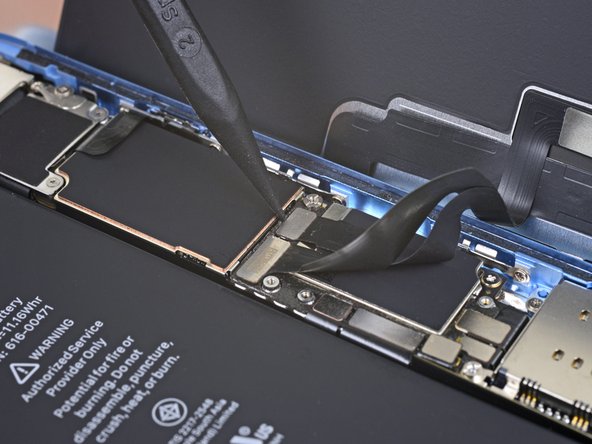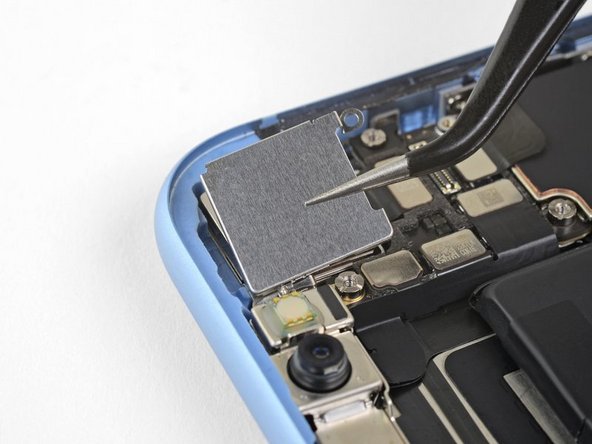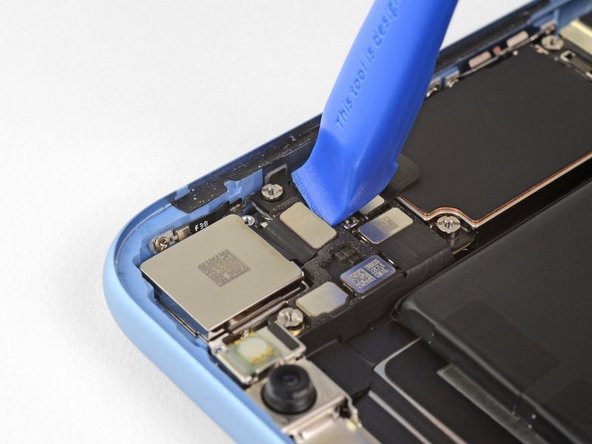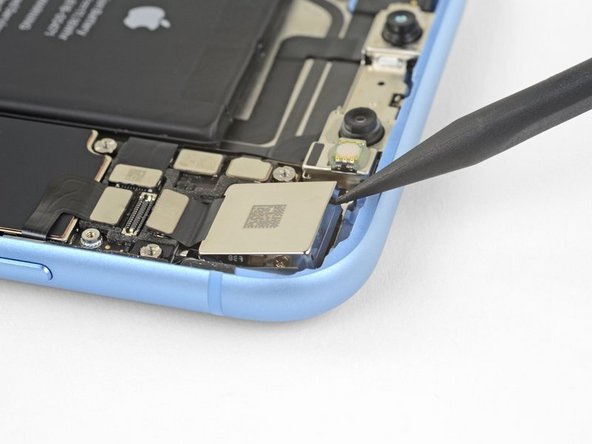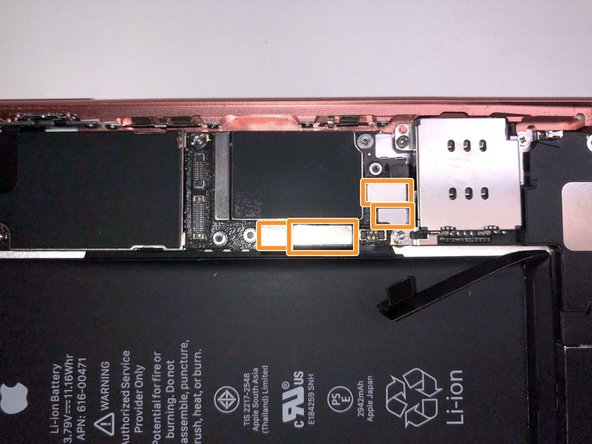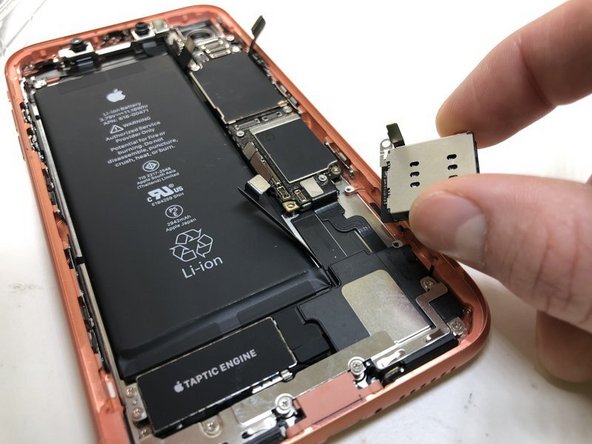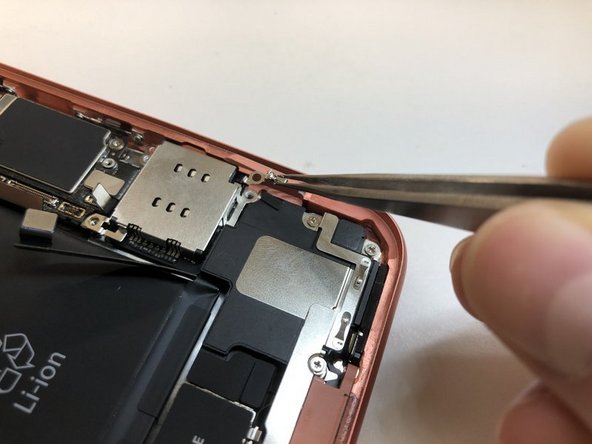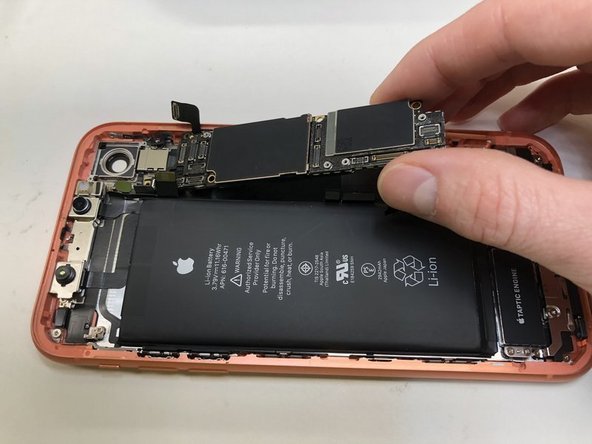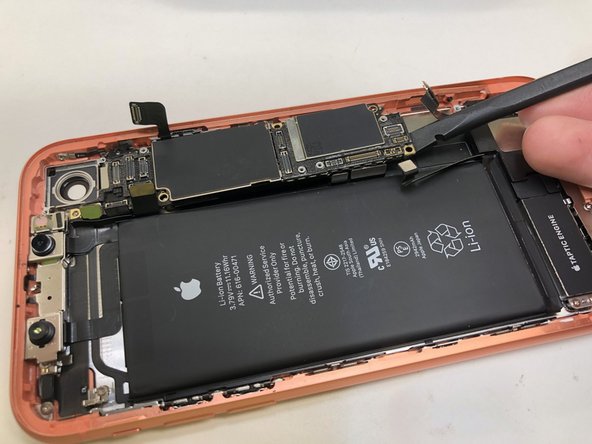iPhone XR Rear Glass Replacement
Duration: 45 minutes
Steps: 48 Steps
Uh-oh, your iPhone XR took a tumble and now the rear glass is looking like a modern art project? No worries—here’s how to swap out that shattered back for a fresh one. We’ll walk through taking the phone apart and putting it all back together in a new frame, step by step. Grab your tools and let’s get that XR looking sharp again!
Step 1
Heads up! For safety, let your iPhone battery dip below 25% before starting. A fully charged lithium-ion battery can get a little dramatic—think sparks or even a mini firework show if punctured.
Opening up your iPhone can break those trusty waterproof seals! So, before you dive in, make sure you've got some replacement seals on hand. If you're planning to put it all back together without swapping those out, just be extra careful to keep it away from any liquids. You've got this!
- Make sure to power off your iPhone before you start taking it apart.
- Unscrew the two 6.7 mm-long pentalobe screws located at the bottom edge of your iPhone.
- Heads up: there’s a black rubber gasket tucked just under the head of each pentalobe screw. To keep dust and liquids out like a pro, check these gaskets and swap them out or replace the screws when you put everything back together.
Step 2
Rock those safety glasses to keep your peepers safe from any sneaky glass shards that might want to escape during your repair adventure.
Got a cracked screen on your iPhone? No worries! Just tape over the glass to keep it from shattering further and to avoid any accidental ouchies while you tackle the repair.
If you're in a pinch, a little superglue on the suction cup can help it stick to the screen like a champ!
- Cover the iPhone screen with overlapping strips of clear packing tape, making sure the whole front is sealed in. It’s like giving your phone a temporary shield.
- If the suction cup just won’t cooperate later, grab some tough tape (duct tape works great), fold it into a handy little tab, and use that to lift the screen instead. Sometimes, you gotta outsmart the sticky situation.
Step 3
Check out the next three steps for a look at the Anti-Clamp—a handy tool designed to make opening your device a breeze. Not using the Anti-Clamp? No worries, just skip ahead three steps for another method.
Want the full scoop on wielding the Anti-Clamp? Take a peek at our dedicated guide.
If your iPhone is feeling slicker than a slip-n-slide and the Anti-Clamp can't get a grip, slap on some tape to give it extra traction.
- Pull the blue handle back to open up the Anti-Clamp's arms.
- Slide the arms onto either the left or right side of your iPhone.
- Place the suction cups near the bottom edge of the iPhone—one on the front and one on the back.
- Press the cups together to create suction on the spot you want to work on.
Step 4
- Grab the blue handle and pull it forward to lock those arms in place.
- Spin the handle clockwise a full 360 degrees, or until you see the suction cups start to stretch.
- Keep an eye on the suction cups — they should stay lined up. If they start to wander off, just loosen them a bit and realign the arms.
Step 5
Take it easy! Just twist a quarter turn at a time and chill for a minute between each twist. Let the Anti-Clamp and some time do their magic for you.
Feeling a bit crafty? You can totally use a hair dryer, heat gun, or even a hot plate! Just remember, too much heat can be a bummer for your display or internal battery, so take it easy and watch the temperature.
If the Anti-Clamp isn't making that sweet gap you need, no worries! Just give it a little more heat and turn that handle a quarter turn for good measure.
- Warm up that iOpener and slide it through the arms of the Anti-Clamp like a pro.
- Bend the iOpener so it rests comfortably on the bottom edge of your iPhone.
- Give it a minute to work its magic and let that adhesive loosen up to create a sweet little gap.
- Gently slide an opening pick underneath the screen and the plastic bezel, but steer clear of the screen itself.
- You can skip the next three steps and keep cruising along!
Tools Used
Step 6
Warming up the bottom edge of your iPhone is a clever way to loosen up that stubborn adhesive holding the display in place. This little trick makes it a breeze to pop it open!
- Grab a hairdryer or heat gun, or if you have one, an iOpener handy! Apply it to the lower edge of your iPhone for about a minute to warm up that sticky adhesive underneath. You're doing great!
Tools Used
Step 7
- Stick your suction handle right onto the bottom edge of the phone—just steer clear of the bendy part of the glass.
Tools Used
Step 8
The adhesive sealing the display is seriously stubborn—breaking that first gap is going to take some muscle. If you're wrestling with it, hit it with a little more heat and try gently rocking the screen until you can slip your tool in.
- Give that suction cup a steady, confident pull to open up a tiny gap between the front panel and the back case. Let gravity know who's boss.
- Slip an opening pick gently under the screen, aiming for the space between the glass and the plastic frame—not under the screen itself. Take it slow, like you're sneaking a cookie from the jar.
Step 9
Keep your pick insertion under 3 mm to avoid poking around where you shouldn’t and potentially harming the inner parts.
- Gently slide the opening pick around the lower left corner and up the left edge of the iPhone, cutting through the adhesive that’s keeping the display snug. You're doing great!
Step 10
Heads up: there are some sensitive cables running along the right edge of your iPhone. Skip the marked areas with your pick—poking around there could mess with those cables!
Step 11
Keep your pick under 3 mm when sliding it in—going deeper might accidentally tap on those delicate display cables!
- Slide your pick back in at the bottom edge of the iPhone and gently glide it up the right side to keep peeling away that stubborn adhesive.
Step 12
Go easy on those clips—if you get Hulk-hands with them, they’ll snap. Slow and steady wins the race.
Keep your pick shallow (under 3 mm) or you’ll risk poking the front panel sensor array where it hurts.
The top edge of the display is held tight with both adhesive and some sneaky little clips.
- Carefully slide the opening pick around the top corner of the display, gently pulling or wiggling the display downward toward the Lightning port as you go.
- Next, glide the pick over to the opposite corner and slice through any leftover adhesive still holding the display in place.
Step 13
- Give the little tab on the suction cup a gentle tug to pop it off the front panel. Easy does it!
Step 14
Hold up—don't yank the display off just yet! There are some delicate ribbon cables still hanging on for dear life, connecting the screen to your iPhone's logic board.
- Start by lifting the iPhone display up from the left side, just like opening a book! It's that simple.
- Once you've got it open, lean the display against something sturdy to keep it propped up while you work your magic on the phone.
- When it's time to put everything back together, gently place the display back in position. Align those clips along the top edge and press the top edge down carefully. It should snap into place! If it gives you a hard time, take a moment to check the clips around the display's perimeter—make sure they're not bent or misaligned.
Step 15
As you go through this repair, keep an eye on those screws—each one likes its own special spot. Mixing them up can lead to iPhone drama nobody wants.
- Unscrew the trio of 1.2 mm Y000 screws holding down the battery connector cover. (Yep, they’re tiny!)
- Lift off the bracket and set it aside like a pro.
- Before sealing everything up, flip on your iPhone and make sure all the features are playing nice. Once you’re satisfied, shut it down completely before moving forward.
Step 16
Be gentle with the black silicone seal around this and other board connections — it’s the unsung hero keeping water and dust out. Treat it like a VIP to keep your device happy and healthy.
- Gently use the pointy end of a spudger to lift the battery connector straight up and out of its socket.
- Carefully bend the connector a bit away from the logic board to keep it from accidentally touching the socket and powering up your phone while you work.
Tools Used
Step 17
- Unscrew the two 1.2 mm Y000 screws holding down the display connector bracket.
- Lift off the bracket and set it aside.
Step 18
- Grab your trusty spudger and gently lift up to disconnect that digitizer cable. You've got this!
- For reattaching those connectors, take your time! Carefully align them and press down on one side until you hear that satisfying click. Then do the same for the other side—just avoid pressing in the middle. If things don't line up, you might bend those little pins, and we definitely don’t want that!
- If your screen is playing hard to get and doesn't respond to touch after your repair, no worries! Just disconnect the battery, reseat that connector, and make sure it clicks in snugly. Also, give the socket a quick check for any dust bunnies or other obstructions—let's keep it clean!
Tools Used
Step 19
- Gently pry open the display cable connector with the tip of a spudger. You've got this!
Tools Used
Step 20
Watch out for that tiny bracket hanging out on the edge! It's held in place by a little clip, and it's super easy to bump it off the larger bracket if you're not careful. Keep it close and secure for the win!
- Let's get those screws out! Start by unscrewing the five screws holding the logic board connector bracket in place, right at the rear case.
- Now, gently lift off the bracket. It should come off without a fight.
- Grab your trusty Phillips #000 and unscrew one 1.3 mm screw.
- Next, there's a 1.5 mm Phillips #000 screw—unscrew that too.
- Finally, finish up with the three 1.2 mm Y000 screws. They're tiny but mighty, so be careful not to lose them!
Step 21
The shield comes in two parts, and the smaller piece is a bit fragile. If it gets damaged, your phone's NFC won't work. Check out the comments below for some clever tips on keeping it safe and sound.
Step 22
- Gently lift the front sensor assembly connector out of its socket using the tip of your spudger. Take it easy—no need to rush this part!
Tools Used
Step 23
- Take off the display assembly with care.
- If you're putting it back together and want to freshen up the waterproof adhesive around the display edges, now’s the perfect time to pause and do that.
Step 24
- Let's get those seven screws out from the bracket chilling under the Taptic engine and speaker:
- Three Phillips screws, 1.4 mm each—tiny but mighty.
- Two Phillips screws, 1.7 mm—slightly beefier.
- One solo Phillips screw, 1.9 mm—standing tall.
- And one more Phillips screw, 1.6 mm—don’t let it hide!
Step 25
- Gently lift the bracket starting from the edge closest to the battery. Remember, it's still attached by a tiny flex cable, so no need to yank it off completely!
Step 26
- With the bracket gently moved aside, use the pointy end of your spudger to pop up and disconnect the flex cable hiding underneath. Easy does it!
Tools Used
Step 27
- Take out the bracket and set it aside like a pro.
Step 28
- Peel back that black tape and lift the tiny rubber rectangle hiding the Taptic Engine connector cover. You’ve got this!
Step 29
When you’re in a bind, a small flathead screwdriver can save the day—just keep a steady hand so it doesn’t slip and mess up nearby parts.
Standoff screws come out easiest with a standoff driver or the right driver bit. Makes life a whole lot simpler!
- Unscrew the five fasteners holding the lower speaker in place:
- One 2.8 mm standoff screw
- One 2.3 mm standoff screw
- One 2.3 mm Phillips screw
- One 1.8 mm Phillips screw
- One 1.6 mm Phillips screw
Step 30
- Take off the tiny bracket chilling at the top right corner of the speaker.
- Lift off the cover protecting the Taptic Engine connector.
Step 31
- Slide your spudger under the top edge of the speaker, right by where it meets the iPhone’s case.
- Give it a gentle lift—just enough to pop up the top edge of the speaker.
Tools Used
Step 32
- Grip the speaker by its sides and gently wiggle it back and forth to loosen up the adhesive sticking it to the bottom edge of your iPhone.
- Carefully pull the speaker away from the bottom edge until you break free from the adhesive grip. Almost there!
Step 33
- Take out the speaker—nice and easy.
- The adhesive gasket holding the speaker in place is a one-time wonder. Use tweezers to clear off any leftover sticky bits.
- For a fresh seal against water and dust, pop in a new adhesive gasket when you put things back together. Clean the area with a little isopropyl alcohol and a lint-free cloth (or even a coffee filter) so the new gasket sticks like a champ. Line up the new gasket on the speaker, then drop the speaker back in its spot.
Tools Used
Step 34
- Take out the two 1.8 mm Phillips screws that are holding the Taptic Engine in place. Easy does it!
Step 35
- Grab a spudger and gently pry the Taptic Engine flex cable straight up from its socket to disconnect it.
Tools Used
Step 36
- Take out the Taptic Engine—just a few screws and it's free!
Step 37
The battery of the iPhone XR is held in place by four pieces of stretch-release adhesive—two at each end of the battery. Let's tackle this together and get that battery out with a smile!
- Each strip of adhesive features a black pull-tab at its end, gently sticking to the battery’s side edge—ready to be pulled when the time comes.
Step 38
Handle that battery with care! Avoid poking it with anything sharp, or you might end up with a leaky mess or worse—a fire hazard! Keep it safe and sound.
- Gently lift the first battery adhesive tab starting at the bottom right corner of the battery to get things moving.
Step 39
Keep those adhesive strips nice and flat—no wrinkles or twists! Otherwise, they'll stick to themselves and snap instead of peeling off smoothly.
Also, avoid pressing down on the battery while pulling the strips. Pushing creates pressure spots that can catch and tear the adhesive.
If any strips break off under the battery and you can’t grab them, carefully remove what’s left and continue with the next steps.
The strip will stretch way beyond its original length! Keep on pulling, and if you need to, grab that strip near the battery again for better leverage.
- Gently peel one of the battery adhesive tabs away from the battery, heading towards the bottom of your iPhone.
- Keep that steady pull going, maintaining a consistent tension on the strip until it gracefully slips out from between the battery and the rear case. For the best results, aim to pull the strip at a nice low angle—just be careful not to snag it on any other components of your iPhone.
- If, by chance, the battery adhesive tabs decide to break during your removal adventure, don’t fret! Just use your fingers or some blunt tweezers to fish out the remaining adhesive and keep on pulling.
Tools Used
Step 40
Keep a firm grip on that battery as you tackle the last strip, or it might just decide to pop out and surprise you!
No need to wrestle the battery out! If it's being stubborn, a couple more drops of alcohol can help loosen it up. Just remember, no poking or prodding the battery with your pry tool!
Watch out for those ribbon cables and the wireless charging coil lurking just beneath the battery. Let's keep them safe and sound!
If the adhesive has decided to play hide and seek under the battery and is nowhere to be found, just drop a few splashes of high-concentration (over 90%) isopropyl alcohol right under the edge of the battery where that pesky adhesive strip has given up. It'll help loosen things up nicely!
And if you're looking for a different way to free that battery, just hang tight and check out the next step below!
- Keep the rhythm going—remove the other three adhesive strips using the same steps.
- No sticky drama? Skip ahead and pat yourself on the back.
- Give it a minute for the alcohol to loosen things up. Then, with the flat end of your spudger, gently coax the battery upwards.
Tools Used
Step 41
If you decide to pry the battery out of the iPhone, take it slow and steady—those ribbon cables and the wireless charging coil underneath are delicate and don’t like rough treatment.
Warm up the iPhone until the back feels a bit too hot to hold comfortably. Just don’t overdo it, or you might accidentally set off the battery’s fireworks.
To keep your fingers safe, wrap the string ends around a cloth or slip on some gloves before you get started.
- If the sticky strips snap and your battery’s still hanging on, grab an iOpener or a hair dryer and warm up the back of your phone behind the battery. This helps loosen up that stubborn adhesive.
- Flip the phone over and slide a sturdy piece of string—dental floss or a skinny guitar string works great—under the battery.
- Move the string back and forth in a gentle sawing motion along the length of the battery to break up the adhesive. It’s a slow process, but hang in there! Be patient, and don’t squash or poke the battery.
Tools Used
Step 42
- Take out the battery from your iPhone.
- If there's any leftover alcohol solution inside, gently wipe it off or let it air dry before popping in the new battery.
- Put the Taptic Engine and speaker back in place before installing the new battery to help keep everything lined up just right.
- Before you stick down the replacement battery, temporarily reconnect its connector to the motherboard socket to make sure it’s sitting perfectly in its spot.
- If your new battery didn’t come with adhesive strips, check out this guide to swap them in.
- After putting everything back together, do a force restart. It helps avoid common hiccups and makes troubleshooting easier.
- Stick the battery down, disconnect it again, and then finish reassembling your device.
Step 43
- Take out the 2 screws holding the camera plate in place
- Lift off the camera plate gently
- Use an opening tool to carefully unplug the camera connector
- One 1.6 mm Phillips screw
- One 2.4 mm standoff screw
Step 44
- Take your spudger and carefully lift the camera out—think of it as giving the camera a gentle nudge to get moving.
Tools Used
Step 45
- Grab a SIM eject tool or a trusty paperclip to pop out the SIM tray. It's as easy as pie!
Step 46
Don't go overboard with the pressure—just a light touch! Too much force could lead to some serious damage to the logic board. Keep it cool and careful.
- Grab an opening tool or your trusty fingernail and gently disconnect those 9 connectors from the logic board. You've got this!
Step 47
- Let’s kick things off by taking out these screws:
- Lift out the grounding bracket—nice and easy.
- Next up, the SIM reader gets to take a break. Remove it.
- Unscrew the 2.9mm standoff screw. You’re on a roll.
- Grab your Phillips #000 and handle the 1.5mm screw.
- And don’t forget the 1.6mm Phillips #000 screw—remove it to finish this round.
Step 48
- To put your device back together, just follow these steps in reverse—easy peasy! And if you hit a snag, remember you can always schedule a repair with us for a hand.













































